a primer
Improve your customer experience
Learn how to provide a better customer experience, even with a small and scrappy team. And if you're looking for a contact center solution that can help you do that, book yourself a product tour of Dialpad's AI-powered customer engagement platform to see how it can make both agents' and supervisors' lives easier.
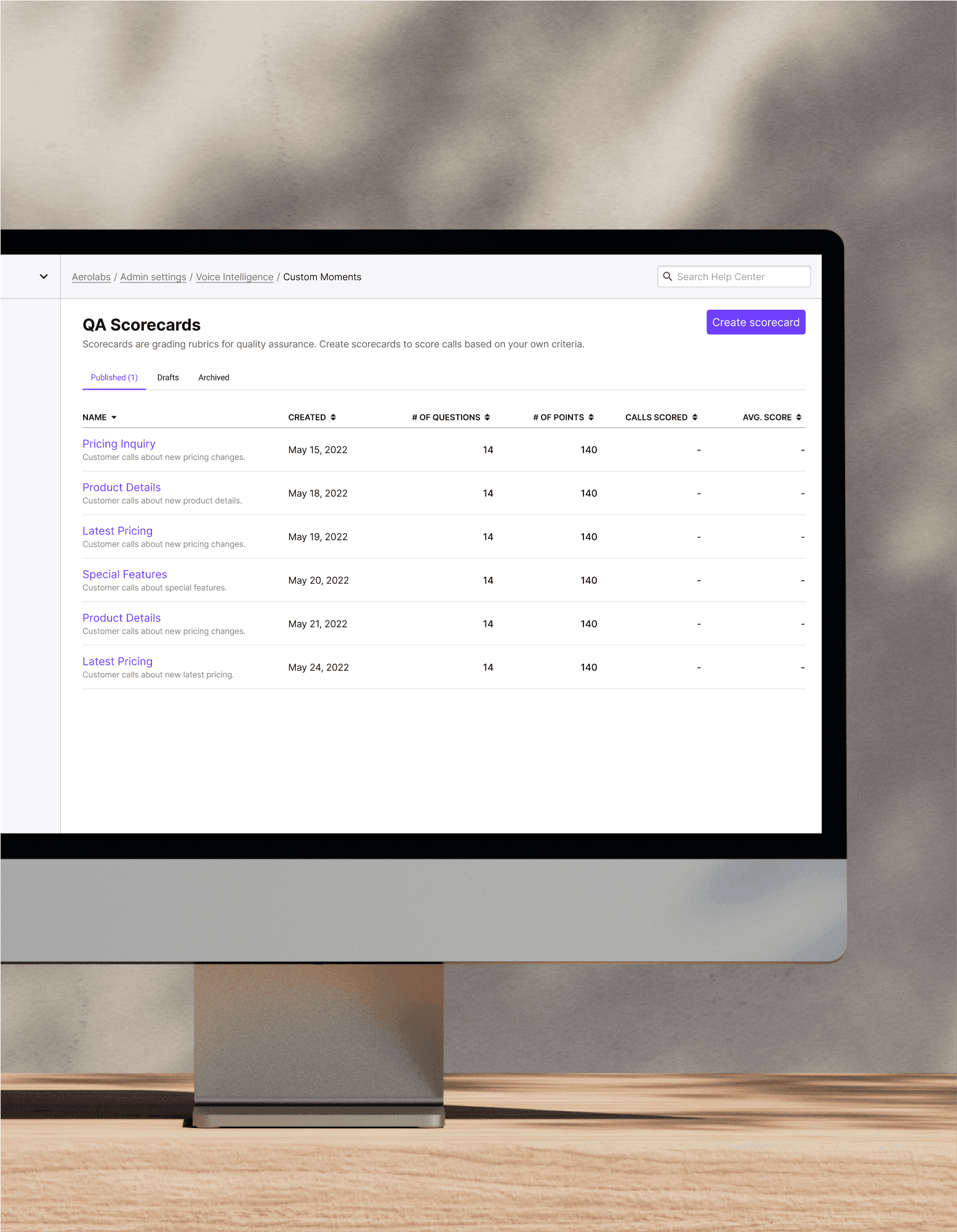
Customer experience, or CX, is central to unlocking so many business benefits.
For businesses, a great customer experience can unlock customer loyalty, long-term growth—and even significant financial savings.
More importantly, your customer experience is one of the best brand differentiators you can have, and can help you stand out from competitors. Zappos, Netflix, IKEA… Many companies have built empires on the strength of their customer experiences, even in crowded marketplaces.
So, how can you continuously improve your customer experience? We’ll walk you through how to do that in this detailed guide.
What exactly is “customer experience” and what does it include?
Customer experience (CX) is a broad term, and typically describes all of the interactions that customers have with a business during their customer journeys.
It’s important to think holistically—onboarding is just as much part of the customer experience as making a payment or chatting with a service rep on the phone or via SMS/MMS messaging.
👉 Dialpad tip:
“Customer experience” is different from customer service, although customer service definitely forms one key part of it. Customer service tends to be more reactive—you’re serving customers as they come to you with problems or questions. The customer experience, on the other hand, encompasses proactive strategies too, like upselling and cross-selling, invitations to referral programs, and more. It goes way beyond just great customer service alone.
How can you measure your customer experience?
“Improving the customer experience” is quite a broad and vague phrase, and it doesn’t really give you much insight into specific ways to improve that experience. More importantly, you need to first know how you’re performing right now before you can find ways to make it better.
This is where KPIs come in. KPIs, or Key Performance Indicators, help you quantify business performance—and can give you that crucial insight into where you can take steps to provide a better experience for your customers.
There are many KPIs and not every company measures the same ones, but here are four fundamental ones to consider as a starting points: Net Promoter Score (NPS), Customer Satisfaction Rate (CSAT), Customer Effort Score (CES), and Customer Loyalty Index (CLI).
These customer experience metrics each provide data about a different facet of your customer experience and can play an important part in informing your CX strategy.
Let’s take a closer look.
NPS: Net Promoter Score
Your Net Promoter Score is essentially a measurement of customer satisfaction and loyalty.
NPS is derived by asking customers how likely they are to recommend your brand, product, or service to other customers (that all-important word-of-mouth). Their rating will take the form of a score between one and 10.
A high NPS score reflects a well-established and thriving relationship between your brand and its customers—learn more about how to calculate it here:

CSAT: Customer Satisfaction Score
Another valuable customer experience KPI is the Customer Satisfaction Score. As its name suggests, CSAT measures the level of customer satisfaction, usually for a specific product or customer touchpoint.
To measure your CSAT, typically you’d ask your customers to rate an individual experience, often as part of a customer feedback survey, from zero (very unsatisfied) to five (very satisfied).
In Dialpad, you can create a CSAT survey in just a few seconds in your online account:
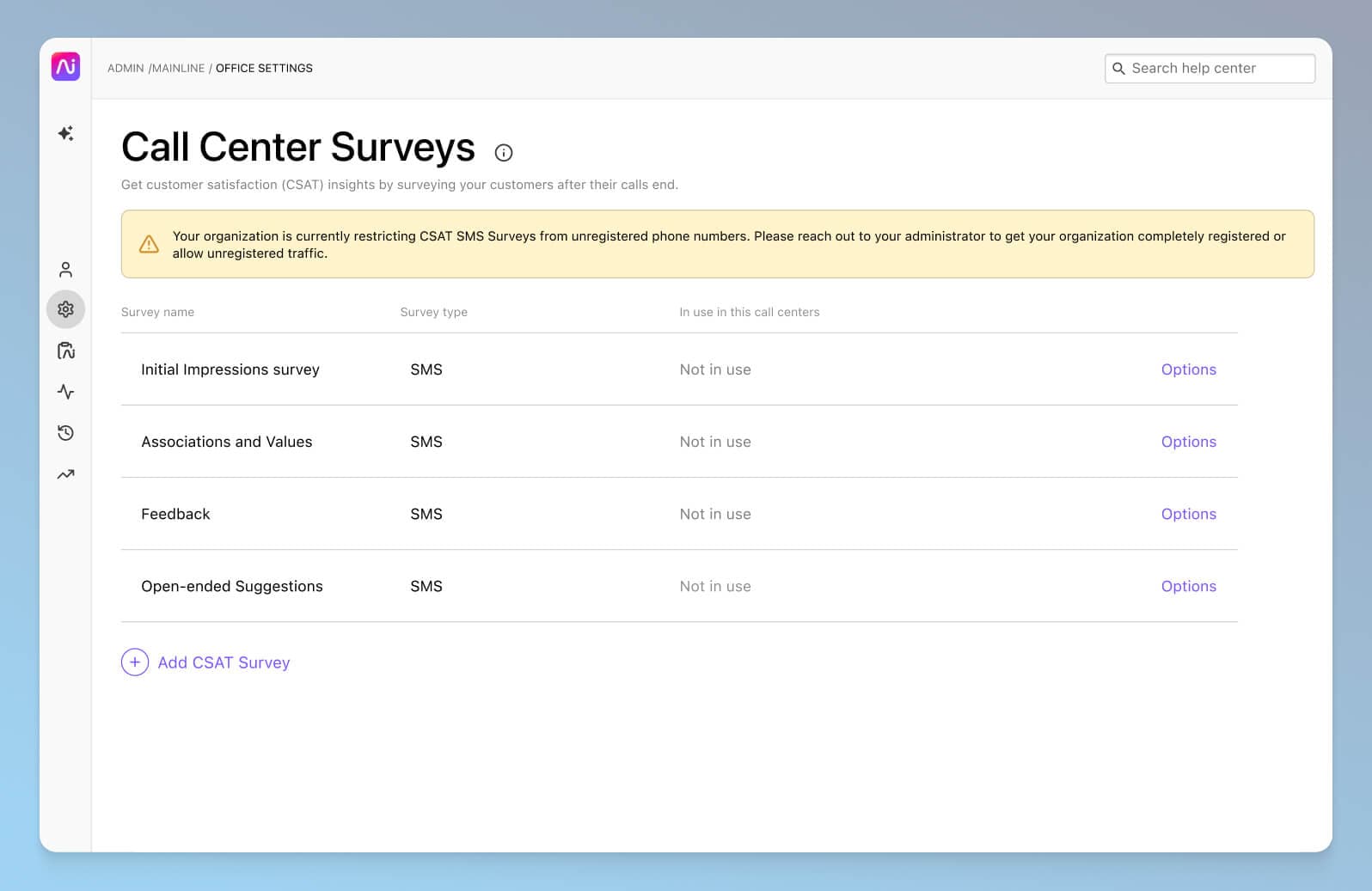
From there, you can add a custom question, which Dialpad Ai will translate from text to speech—and you can also add a follow-up question that asks your customer or caller to elaborate on why they gave you the score that they did:

👉 Dialpad tip:
Think of NPS as taking a macro view of customer experience while CSAT focuses on the micro-elements of CX. In tandem, they’re a powerhouse of customer information.
CES: Customer Effort Score
Your Customer Effort Score will measure how much effort a customer must put in to get something done. That could be the effort taken to get a product purchased, the effort taken to get a problem solved, or simply the effort taken to get a question answered.
CES is usually measured by asking customers questions like this on a survey:
“On a scale of one to 10 (one being very easy and 10 being very difficult), how easy was it to get what you needed today?”
These questions should be asked immediately after the interaction or touchpoint in question (often an email, live chat, social media, or phone call). The best way to implement this measure is to provide multiple opportunities for feedback throughout your online user experience.
Why would you want to know how “easy” a customer's experience was? Well, in general, the easier it is for your customers to get what they need, the more likely they are to return for second, third, or fourth purchases.
CLI: Customer Loyalty Index
Customer Loyalty Indexing tracks customer loyalty over time. This is a more comprehensive approach to customer loyalty than, say, NPS or CSAT.
CLI isn’t a standalone metric. Instead, CLI takes into account various other customer experience metrics such as NPS, and other factors like upselling or repurchasing.
Typically a CLI questionnaire will pose three types of questions:
How likely a customer is to recommend the company to other customers
How likely a customer is to repeat purchase in the future
How likely a customer is to try other products in the future
A score will then be generated based on these responses. You could then evaluate your CLI scores regularly to assess customer loyalty over time.
✨ See how these contact center teams improved their CX
Grab the Contact Center Playbook, which breaks down everything you need to know, from setup to staffing to optimizing—with examples from real contact center teams across different industries.
Other metrics to consider
There are so many useful metrics out there. As well as these four must-haves, you might want to support your customer experience tracking with a variety of KPIs. These include metrics like CLV (Customer Lifetime Value), churn rate, and more, and some cloud contact center platforms come with analytics dashboards that help you track these numbers.
Churn rate
Churn rate measures the speed at which customers are lost. In other words, the rate at which your customers leave and never return. Needless to say, you want a low churn rate.
To establish true business growth, you’ll want your growth rate (percentage of new customers) to outnumber your churn rate (percentage of leaving customers).
CLV: Customer Lifetime Value
Customer Lifetime Value is an expression of the total worth of a customer to your business over the duration of your customer relationship. CLV is a key metric when it comes to strategizing how to onboard new customers and retain existing ones.
You’ve probably heard of many stats about how it costs less to keep existing customers than it does to acquire new ones—so increasing the lifetime value of your existing customers is a key way to drive growth.
Unlike NPS and CSAT, which measure loyalty in terms of satisfaction, CLV links a customer’s lifetime value directly to revenue (which makes it particularly important for business leaders).
Average Resolution Time
Average Resolution Time measures how long, on average, it takes your support teams to resolve an issue. Your Average Resolution Time is an expression of the total time taken across all resolved conversations, divided by the total number of resolved requests.
This KPI is primarily designed to measure efficiency. What are your response times like, and if things are looking a little slow, what changes can you make to ensure that your customers are getting the help they need as quickly and efficiently as possible?
Companies can boost their average resolution time with improved quality monitoring of their contact center performance—and you can generally do this with a good contact center platform. A quick tip: choose a versatile platform that can do multiple things well instead of multiple disparate tools. It’ll be easier for you and your agents to learn and manage the tool (and the single monthly software subscription fee often costs less too).
With Dialpad, for instance, we have a whole range of dashboards and data at our fingertips and can always get a holistic view of how our contact center teams are doing. One of our favorite features: the heat maps that track call volume patterns and our average speed to answer:
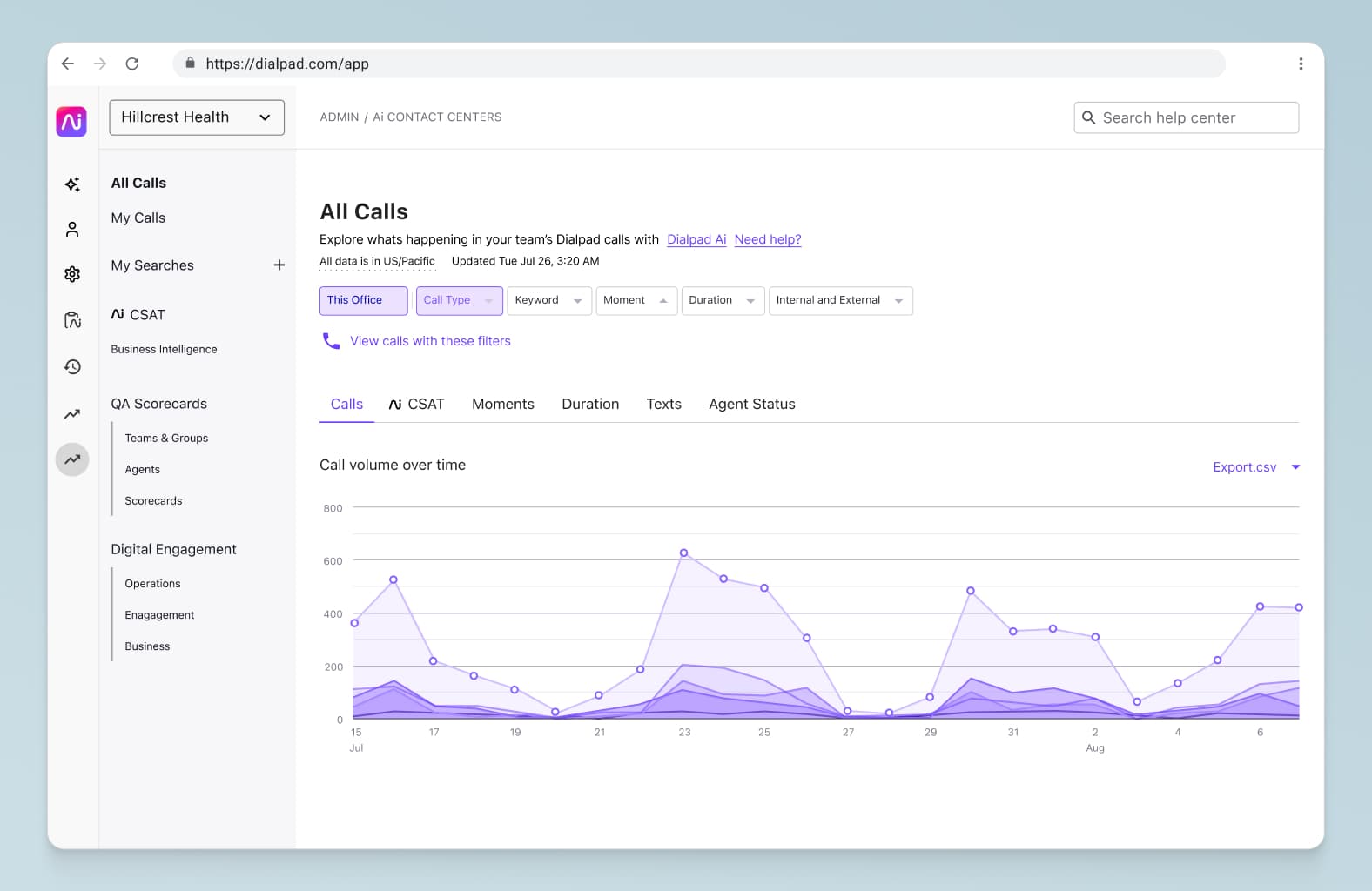
Want to improve your customer experience?
If you need an easy-to-use contact center solution, Dialpad is designed for you. You can add agents on your own in minutes, move them between different queues and teams, and even get built-in analytics for your most important metrics. Book a demo or take a self-guided interactive tour of the app!
4 ways to improve the customer experience
So, we know that improving our customer experiences is a good thing. But how can we start to do this in actionable terms? What is it that makes for a truly great customer experience?
Businesses with the very best customer experiences will focus on different types of customer interactions and touchpoints throughout the entire customer lifecycle.
From onboarding to post-sales support, every interaction should be as seamless and easy as possible.
That means ensuring that customers can purchase your products or book services easily online, and that your customer support is effective and readily available. It means that your customers have peace of mind that their data is secure, and that they never have to wait too long to chat with a member of your team.
Yes, it’s a lot. Now, let’s look at how to achieve just that.
1. Build a clear customer journey
Before you can improve the experience, you need to have a holistic and accurate picture of your current customer journey from start to finish. This is typically done by creating a “customer journey map,” which basically gives you a comprehensive visualization of every touchpoint where customers come into contact with your business.
One simple way to do this is to start by breaking down your customer journey into a few key components: objectives, personas, touchpoints, and resources.
Objectives
What do your buyers want to achieve by purchasing your products or services? These are your buyer objectives.
Of course, the answer will depend on what your business offers. If you’re operating a fashion retail brand, for example, your customer’s objectives might look something like this:
Easily search for clothing items via browser and mobile
Get comprehensive product information and pricing for each listing
Buy with a simple purchase process and reliable returns policy
Get amazing post-purchase support
✒️ Grab the Contact Center RFP Checklist
Vetting different contact center solutions? This RFP checklist covers the essentials to be aware of and why they may be important for your contact center.
Personas
In order to accurately define your buyer objectives, you’ll need to define your brand’s buyer personas. In other words, who is your target market and what do these people want?
You’ll most likely have a variety of different buyer personas engaging with your brand and people at different buying stages will behave differently. It’s important to tailor your consumer experiences to suit these specific personas as much as you can.
Touchpoints
Hone in on all of the major touchpoints that your customers will come into contact with along their customer journey.
A touchpoint is simply an interaction, and touchpoints can occur at the beginning, middle, and end of the sales cycle.
Examples of touchpoints could be a phone call with your customer support team, an online payment, live chat, check-in, and so on.
All of these touchpoints should work together as seamlessly as possible. For example, if a customer emails a company with a question about a purchase they made, ideally the company should be able to pull up that customer’s account and have the information ready without making the customer repeat everything.
This is when it’s important to have a CRM (customer relationship management) software, since you can log your customers’ past interactions and history with your company there—including phone numbers and email addresses.
For example, Dialpad integrates with tools like Salesforce and Zendesk so that when a customer calls, an agent can have a full view of their past interactions with the company—even if that agent has never spoken to that customer before:
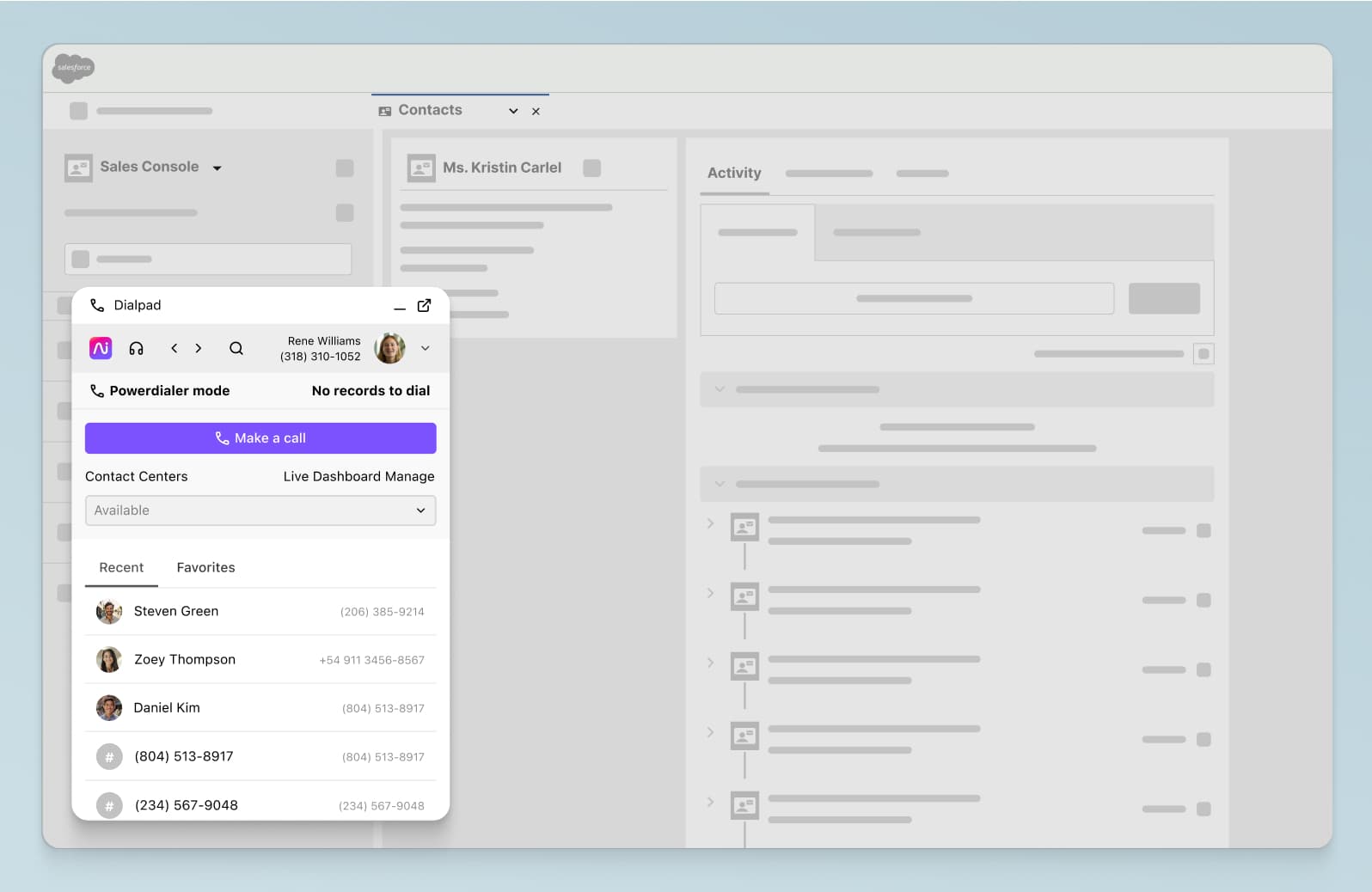
Resources (for your customers)
Finally, think about the resources that your target personas will need.
Generally, you should have some self-service options, like an online FAQ page or knowledge base so that your customers can easily find answers to basic questions on their own whenever they want. Not only is this convenient for them, it’ll also relieve pressure on your frontline support team.
For example, Dialpad has a very detailed knowledge base that our customers can access online anytime.
For most companies, customers aren’t just calling you on the phone anymore for things like customer support. They might be emailing you, messaging you on social media, texting you—and even using an “offline” channel” on the rare occasion: coming into your store in-person.
With so many channels, it’s often difficult to be responsive on every single one. Technology is your best friend here, and can help you stay up to date on customer conversations across all these channels in just one platform or window.
For example, your contact center platform should integrate with ticketing or helpdesk software, live chat tools, CRMs, and any other types of software where your conversations are taking place. This will give you a 360-degree view of your customer experience.
If your business is on the phones a lot in addition to other channels, then something like Dialpad can integrate with tools such as HubSpot, Front, and Intercom as well. Not only that, it also comes with omnichannel contact center functionality like live chat and chatbots—built right into the product. Make phone calls, message teammates, host video meetings, and communicate with your customers on whichever channel they prefer:

2. Use AI and automation
There’s a ton of software and tools out there that talk about AI and automation and how this technology can help improve your customer experience. But what exactly can a business do with AI?
One of the biggest benefits is that you can get real-time data derived from your customer interactions.
For example, Dialpad Ai not only transcribes customer calls in real-time, you can also choose keyword topics for it to track. For example, if you want to know why customers are calling to ask for refunds, you can set up a “Custom Moment” in Dialpad to track every time a customer says “refund” on a call:
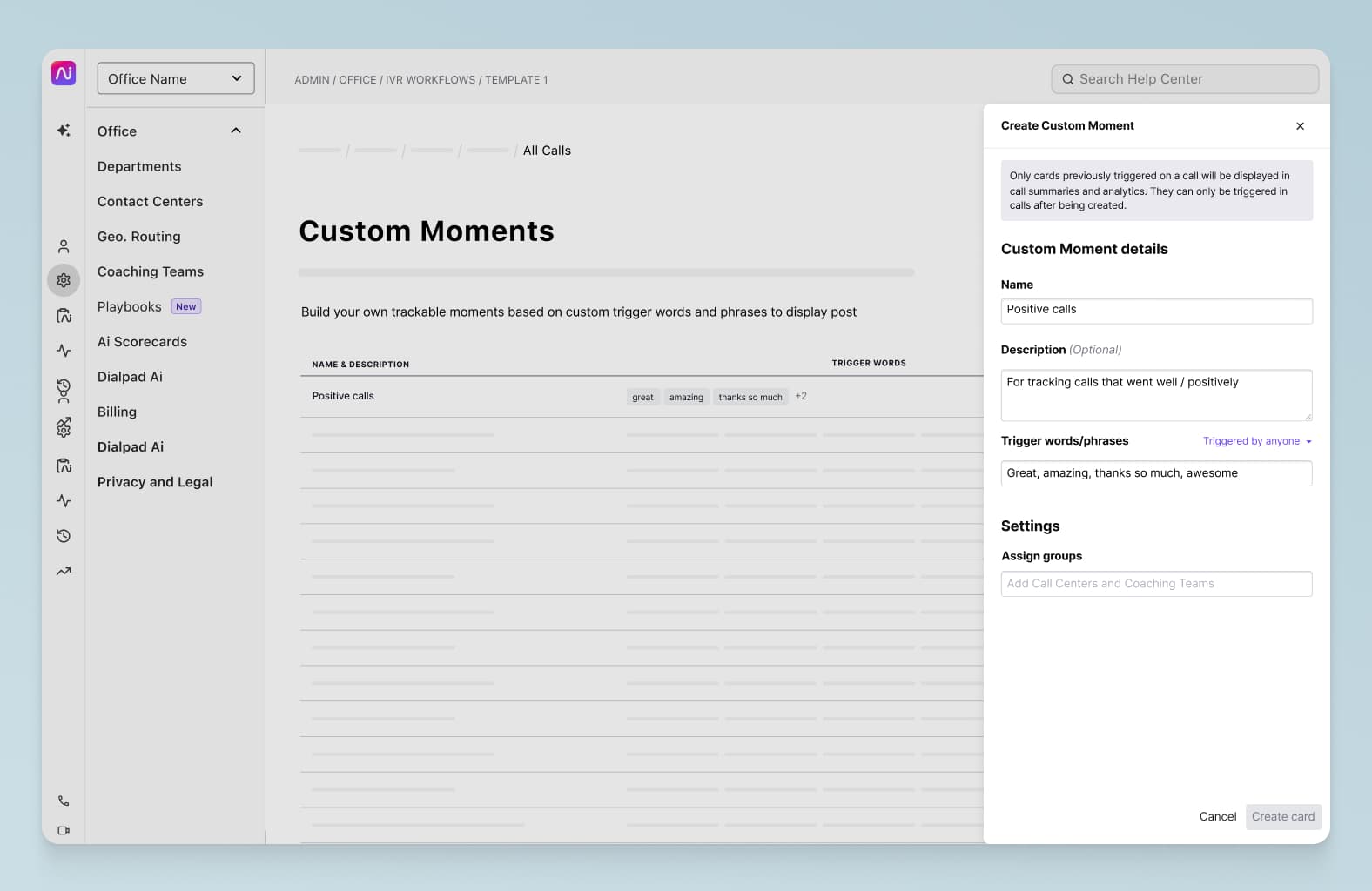
You’ll then be able to track how frequently these keywords or topics come up over time on calls, dig into transcripts to understand the context of these conversations, and use this customer feedback to improve your overall experience.
You can also automate training for your customer experience teams with Dialpad Ai. For example, if you know that customers are asking your agents tricky questions about a certain feature, you can create Real-time Assist (RTA) cards that are essentially cheat sheets that automatically pop up on your agents’ screens when certain keywords are spoken on a call.
If customers are asking lots of questions about how to port a phone number over, for instance, a contact center supervisor could create an RTA card with notes about porting to help agents on calls—without having to coach every single call personally:

Not only does this help agents perform better, it also automates part of the learning process for new hires.
3. Take action based on feedback
Feedback remains one of the most effective ways to monitor customer experiences. So make sure that you’re taking stock of customer and employee feedback regularly.
Customer feedback
Ask your customers how they rate your products and services via live chat (always preferable to chatbots), feedback forms, follow-up emails, surveys, calls, and pop-ups. Use CSAT (customer satisfaction) surveys, and look for nuggets of insights in recordings and transcripts of customer interactions. These can be useful case studies for both training support agents and also for marketers as they tailor their campaigns.
Employee feedback
Conduct periodic employee surveys to gauge how your team is feeling. How engaged, motivated, and satisfied is your team of agents? Happy and empowered agents are key to positive customer relationships—and yet agent turnover in contact centers is notoriously high. They’re your first line of defence and your most valuable assets. Treat them as such!
4. Measure, measure, measure
Last but not least, measuring your ROI is crucial to the success of your overall customer experience strategy. What are your service levels? How successful are your quality monitoring efforts? You have to measure before you can improve.
Why is being customer-centric crucial to your business?
A good customer experience is vital for business.
Satisfied customers become loyal customers, and loyal customers bring in revenue.
Often, people see being customer-centric as a nice-to-have, not a must-have—when in reality, it’s key to your bottom line. Here are a few reasons why
Increases loyalty and retention
Onboarding a new customer can cost seven times more than holding on to an existing one. If there’s a more impactful argument for being customer-centric and focusing on earning loyal customers, we haven’t seen it.
Improves conversion rates and boost sales
Prioritizing your customers’ needs isn’t just a “nice” thing to do. Companies do it because better customer experience will make it easier to guide your potential customers to the desired action: a purchase.
Look at some of the best customer experiences from your favorite companies. How easy is it purchase—and re-purchase—with them?
Saves money (really)
Finally, by improving your customer experience, you can save money. How?
Many companies spend exorbitant amounts of money on customer retention and marketing. And often, they need to do this because their customers are churning (leaving) at a high rate, which makes it hard for these businesses to grow.
What if your CX was so good that your customers (almost) never leave? What if your CX was so good that not only do they churn at an extremely low rate, they also bring you more business? (Yes, negative churn is real, and it’s awesome.)
How will you personalize and improve your customer experience?
Customer experience management is one of the most important skills a business can cultivate, especially today when one bad experience can make a customer leave for a competitor.
With the right tools, you can create an experience that anticipates customer pain points, exceeds customer expectations and earns happy customers that stick with your business over the long term.
Want to create a positive customer experience across different channels?
Book a demo of Dialpad Ai with our team, or take a self-guided interactive tour of the app on your own!
